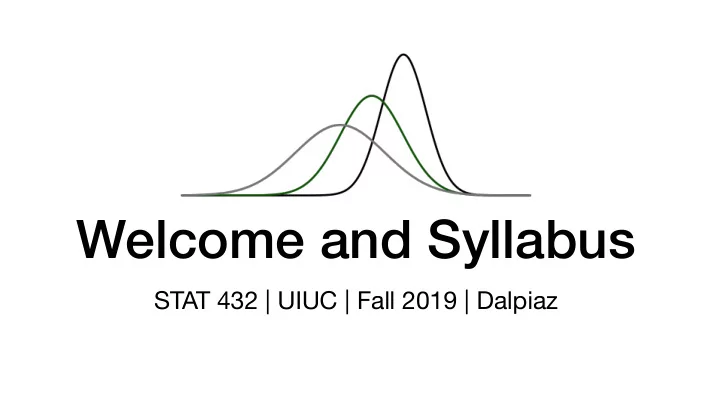

Welcome and Syllabus STAT 432 | UIUC | Fall 2019 | Dalpiaz
Questions? Comments? Concerns?
STAT 432 Basics of Statistical Learning Also ASRM 451….
stat432.org
DAVE
dalpiaz2@illinois.edu David Dalpiaz Room 36, 703 S. Wright
David Dalpiaz Mengchen Wang Zihe Liu Instructor Teaching Assistant Teaching Assistant
Course Logistics
Prerequisites?
Course Description Topics in supervised and unsupervised learning are covered, including logistic regression, support vector machines, classification trees and nonparametric regression. Model building and feature selection are discussed for these techniques, with a focus on regularization methods, such as lasso and ridge regression, as well as methods for model selection and assessment using cross validation. Cluster analysis and principal components analysis are introduced as examples of unsupervised learning.
Course Description Machine learning form the perspective of a statistician who uses R.
Learning Objectives After this course, students should be expected to be able to … identify supervised (regression and classification) and unsupervised (clustering) • learning problems. understand the fundamental theory behind statistical learning methods. • implement learning methods using a statistical computing environment. • formulate practical, real-world, problems as statistical learning problems. • evaluate e ff ectiveness of learning methods when used as a tool for data analysis. •
Basics of Statistical Learning
Course Format • Three lectures per week. (Unimportant?) • Sometimes slides, sometimes board notes, sometimes computing. • (Important!) Things you will do: • (Practice) Quizzes on PrairieLearn • Exams at the CBTF • Data Analyses • Projects
Assessment Percentage PrairieLearn Quizzes 20 CBTF Exam I 10 CBTF Exam II 10 CBTF Exam III 20 Practice Data Analyses 10 Data Analyses 10 Group Final Project 15 Graduate Project 5
A+ A A- B+ B B- C+ C C- D+ D D- TBD 93% 90% 87% 83% 80% 77% 73% 70% 67% 63% 60%
Computing Resources
PL and CBTF
Additional Class Technology
• Use @illinois.edu email • Begin subject with [STAT 432] • Get to the point! • Probably just use Piazza …
Office Hours Wednesday 4:00 - 7:00
“I don't know who you are. I don't know what you want. If you're looking for ransom, I can tell you I don't have money... but what I do have are a very particular set of skills. Skills I have acquired over a very long career. Skills that make me a nightmare for people like you…”
Not registered?
“I am altering the deal, pray I don’t alter it any further.”
Questions? Comments? Concerns?
ML in 5 Minutes
Supervised Learning Classification
Let’s train you to be a classifier…
This is a Snorlax.
This is a Pikachu.
This is a Raichu.
This is a Snorlax.
This is a Raichu.
This is a Pikachu.
Now that you are a classifier, let’s make some predictions…
What Pokémon is this?
What Pokémon is this?
What Pokémon is this?
What might the “data” look like? Class (y) Color (x1) Height (x2) Weight (x3) Type (x4) Pikachu Yellow 0.4 m 6.0 kg Electric Snorlax Blue 2.1 m 460.0 kg Normal Raichu Orange 0.8 m 30.0 kg Electric … … … … …
A non-exhaustive list of questions… • How would you go from an image to a data frame? • Which predictors should we use in our model? • How do we model the response as a function of the predictors? • How to we use our model to make predictions? • How do we know if our model is working well? • Who cares?
Supervised Learning Regression
It’s pretty much the same as classification except you’re predicting a number instead of a category.
Unsupervised Learning Clustering
Can you “group” these Pokémon?
Maybe like this?
How about like this?
Why not like this?
An non-exhaustive list of questions… • How do you measure the similarity between observations? • How many groups should there be? • How do you assign observations to groups? • Who cares?
The Extended Syllabus
At the end of the course, I hope that students feel they are… • A better statistician . • A better programmer . • A better learner .
grade = f ( prior knowledge , e ff ort , luck )
“You must unlearn what you have learned.”
Things I sort of wish you didn’t know about: • R-Squared • Leverage • Cook’s Distance • Variance Inflation Factors • P-Values???
Things I would be happy to never see or talk about in this course. • MSE as a model metric. (Hint: use RMSE. MSE is appropriate in theoretical discussions.) • Removing outliers based on leverage or Cook’s distance. • Removing predictors to reduce variance inflation factors. • Calling a standard error a standard deviation or vice versa. • Model selection based on p-values of individual coe ffi cients. • R-Squared. • Causality. (Unless you’re really sure you should. Hint: you shouldn’t.) • SAS. (Feel free to bug me about Python though…) • Mixing assignment operators. (Or poorly styled code in general.) • Using ASRM instead of STAT. (There are eight sections of this course because of this…)
Facts versus Opinions
Data Science Big Data Deep Learning Predictive Analytics Artificial Intelligence Machine Learning
“Won’t you be my neighbor?”
“There are known, knowns…”
“Show up, don’t quit, ask questions.” –Dan John
Student Health • Diet • Exercise • Sleep
Expectations?
Feedback?
Questions? Comments? Concerns?
Homework • Bookmark the course website. • Read the full syllabus!!! • Read the extended syllabus. • Register for course on PrairieLearn . • Register for course on Piazza . • Register for the CBTF Syllabus Exam. • Register for course on RStudio Cloud ? • We’ll walk through this next time.
Recommend
More recommend